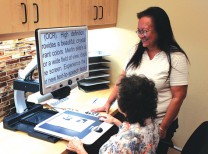Approximately 800,000 people suffer a stroke every year, making it is the most common disability among adults. There are two basic types of strokes: an ischemic stroke (when a blood clot blocks a blood vessel) and hemorrhagic stroke (when a blood vessel ruptures or leaks). Some stroke patients have preceding symptoms called transient ischemic attacks (TIA) which are temporary interruptions of the blood supply to the brain. TIAs can occur hours, days or even weeks before a full stroke. Symptoms may include temporary episodes of weakness, numbness, paralysis of the face, arm, leg (especially on one side), or loss of balance and/or coordination. Also included in this list is transient or permanent double vision, loss of visual field or improper eyelid closure.
Diplopia (double vision)
Recent onset intermittent or persistent double vision, or diplopia, is a common complication of a stroke. To solve this problem a temporary prismatic correction (called a Fresnel lens) can be used or the patient can patch or occlude the eye with the limited gaze. Post stroke range of motion in the affected eye can be improved with exercise. Most cases of vertical double vision are only stable in one field of gaze; therefore, even if a vertical prism correction is prescribed, the patient needs to perform a head tilt or learn to turn their head to the corrected orientation to avoid double vision. Resolution of most cases of diplopia and adaptation occurs in the first three months, so it’s important that a patient seek care in that timeframe in order to avoid deeply imbedded suppression (the brain turning the image from one eye off). In a patient with neuro-related double vision, damage to the brain pathways can occur and the best solution may be to alternately patch eyes.
Hemianopsia (loss of vision in one half of the visual field)
Behind the optic nerve the visual pathway is split with the left visual field going to one part of the brain and right visual field going to the other. Cerebral stroke most often involves losing either the left or the right field (depending on where the stroke occurs). Recent onset hemianopsia field loss leaves a person disoriented and struggling to make it through daily living. They are often confused in busy visual environments such as a mall and they may bump into people or have the fear of falling off a curb. Usually the visual field loss is permanent, so optical corrections may compensate for the visual field loss. As a minimum two separate pairs of glasses are needed: one for distance and one for near. There are specifically designed lenses called SVAG (Side Vision Awareness Glasses) that expand the patient’s vision in the affected side.
Eyelid Paresis
Some patients develop ptosis (droopy eye) following stroke and blepharoparesis (the inability to close the eye), which dries the cornea and may result in damage. A topical ointment, plugs and an eyelid weight are used to help close the eye and prevent damage. This often improves over time but may require long-term care.
In summary, patients require specialized care following a stroke. Often times a significant field loss can be present but the patient may be unaware of this. Make sure a patient seeks care if they see double, have a droopy eyelid, problem closing the eye, or if they report part of their field missing.
Dr. Evans is the founding owner of Evans Eye Care in Palm Desert and can be reached at (760) 674.8806 or online at www.evanseyecare.com.













































Comments (0)